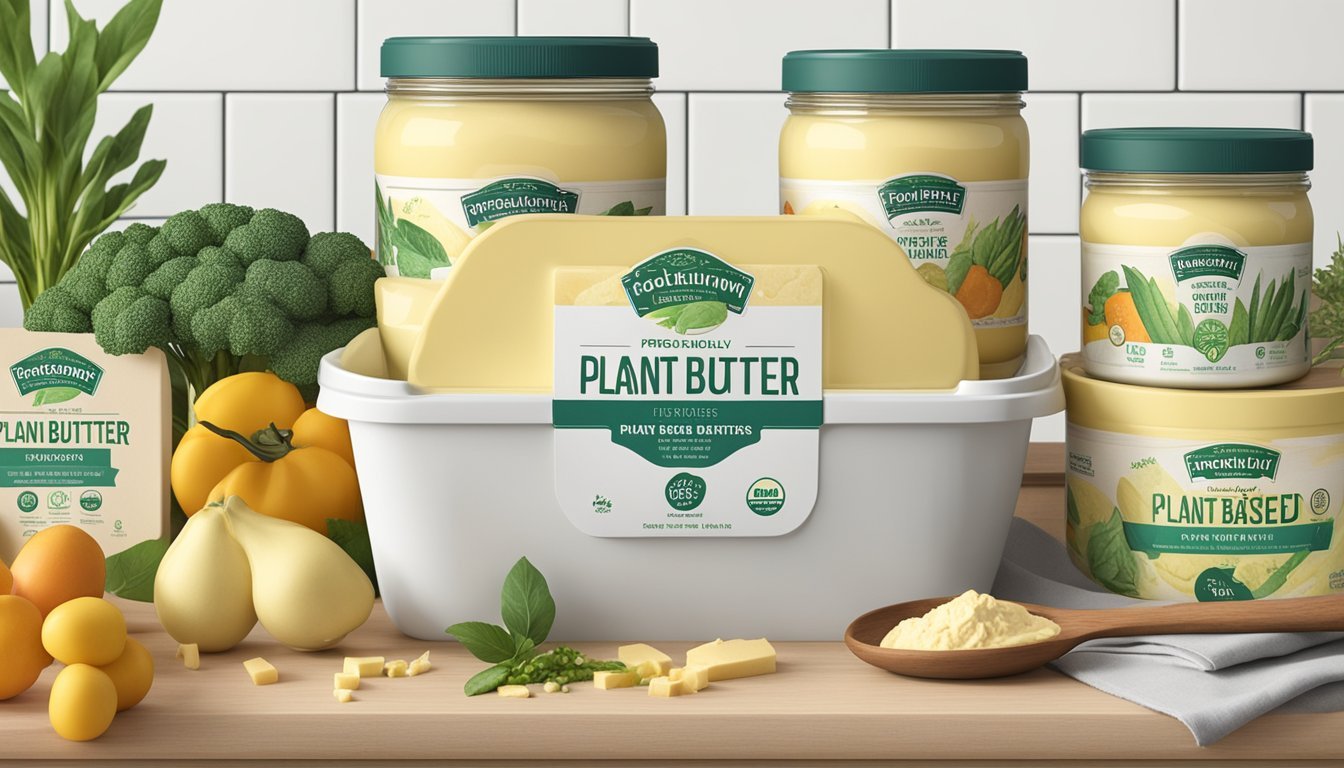Does Plant-Based Butter Go Bad?
Shelf Life and Storage Tips
Plant-based butter has become a staple in many kitchens, offering a vegan-friendly alternative to traditional dairy-based butter. Plant-based butter does go bad, but it typically lasts longer than dairy butter when stored properly. This is partly because plant-based options do not go rancid as quickly at room temperature.
The ingredients in plant-based butter, primarily plant-derived oils, contribute to its extended shelf life. However, to maintain its freshness and prevent it from going sour, it's best to store it in the fridge. Signs that the plant-based butter has gone bad include changes in flavor or odor.
For those questioning the longevity of their plant-based butter, keeping it well-refrigerated is key to preserving its quality. This makes it a convenient and reliable option for those looking to make a healthier switch without frequent spoilage concerns.
Understanding Plant-Based Butter
Plant-based butter, also known as vegan butter, is crafted from a variety of plant oils and fats, offering a dairy-free alternative with distinct nutritional differences from traditional dairy butter. This section explores its composition, comparison with dairy butter, various types, and its health and nutrition profile.
Composition and Ingredients
Plant-based butters are primarily composed of plant-derived oils and fats. Common ingredients include coconut oil, avocado oil, olive oil, and vegetable oil.
In addition to oils, these butters may contain water, emulsifiers, additives, colorings, and preservatives to enhance texture and shelf life. The inclusion of emulsifiers ensures a consistent creaminess, and preservatives help in extending the product's freshness.
Comparison with Dairy Butter
When comparing vegan butter to traditional dairy butter, key differences arise in fat composition and nutritional content. Plant-based butters typically have lower saturated fats and cholesterol, since they do not contain any animal products.
Dairy butter is rich in saturated fats, impacting heart health. Vegan butter, on the other hand, often includes healthier fats, such as monounsaturated fats, which are beneficial for blood sugar control and may reduce the risk of heart disease.
Types of Plant-Based Butters
A variety of plant-based butters are available to suit different tastes and dietary needs. Coconut oil-based butters provide a tropical flavor and are excellent for baking and desserts.
Avocado oil-based butters offer a creamy texture suitable for spreading and cooking. Olive oil-based butters bring a rich, savory taste, ideal for Mediterranean dishes. Diverse formulations cater to those looking for specific flavors, textures, and cooking applications.
Health and Nutrition Profile
Nutrition in plant-based butters is often highlighted by the types of oils used. They can be high in calories and total fat but typically offer beneficial monounsaturated fats.
These fats have been associated with reduced chronic inflammation and lowered levels of apolipoprotein B, a marker of heart disease. Additionally, some plant-based butters are enriched with vitamins and minerals to mimic the nutritive profile of dairy butter, appealing to those mindful of heart health and managing cholesterol levels.
Sodium content is another factor to consider, as it can vary widely among different products. Despite being high in total fat, the healthy fats in plant-based options can positively impact body weight regulation and chronic diseases management.
Shelf Life and Spoilage
Plant-based butter can spoil like any other food product. Key factors that influence its shelf life include ingredients, storage conditions, and expiration dates.
Signs of Rancidity and Mold Growth
Signs of rancidity in plant-based butter include unpleasant odors and changes in taste. It may develop a sour or off smell, indicating the oils within have deteriorated.
Mold growth can appear as visible spots, often green or black, on the surface. These signs suggest bacterial contamination and make the product unsafe for consumption.
Impact of Ingredients on Freshness
Plant-based butter often contains oils, plant-based milks, and sometimes preservatives. Oils, especially unsaturated ones, tend to go rancid faster. Plant-based milks contribute moisture, which can foster bacterial and mold growth.
Preservatives like salt and natural stabilizers can extend shelf life. Products with fewer preservatives or salt need stricter storage conditions to remain fresh.
Expiration Date and Food Safety
Always check the expiration date on plant-based butter packaging. Storing it properly in temperatures below 40°F can extend its usability.
Freezing can prolong its shelf life to over six months. Despite expiration dates, if plant-based butter develops off smells or visible mold, it should be discarded to avoid health risks.
Proper Storage and Handling
Proper storage and handling of plant-based butter are crucial to maintaining its quality, flavor, and safety. With attention to optimal conditions, consumers can significantly extend its shelf life.
At Room Temperature
Plant-based butter generally benefits from refrigeration, but it can also be kept at room temperature for short periods. To ensure it remains safe, store it in a butter crock or an airtight container. This prevents exposure to air and contaminants which can speed up spoilage. Using a cool, dry place away from direct sunlight further helps in maintaining its consistency and taste. Remember that high temperatures can cause plant-based butter to melt, affecting its texture.
Refrigeration Best Practices
Refrigerating plant-based butter is essential for longer shelf life. Keep it sealed in its original packaging or transfer it to an airtight container to prevent odor absorption from other foods. The refrigerator should be set to a temperature between 33°F and 40°F. Regularly check the butter for any signs of spoilage, like changes in color, smell, or texture. Plant-based butter often contains oils and plant-based milk, which benefit significantly from refrigeration to stay fresh.
Freezing for Extended Preservation
For those looking to store plant-based butter for an extended period, freezing is an excellent option. Wrap the butter in its original packaging and place it in a freezer-safe airtight container or a zip-top bag. This prevents freezer burn and keeps out moisture. Plant-based butter can typically be frozen for up to six months. To use, thaw it in the refrigerator to retain its creamy texture. Make sure to label the container with the date of freezing to keep track of its freshness.
By adhering to these storage and handling practices, plant-based butter can be kept fresh and safe for consumption, maximizing its shelf life.
Culinary Uses
Plant-based butter is a versatile ingredient in the kitchen. It serves many purposes from baking to spreading on toast, and even making your own vegan butter at home. Explore how it fits into various culinary applications.
Baking and Cooking
For baking, plant-based butter works well in place of traditional butter. Products like vegan buttery sticks provide a similar texture and functionality. They can be used in cookies, cakes, and pie crusts, ensuring a rich flavor and proper consistency.
Melted vegan butter can enhance sautéed vegetables or be used in sauces and gravies. Its higher smoke point makes it ideal for light frying. When substituting in baking, pay attention to the fat content, as it can affect the moisture and structure of the final product.
Spreads and Toppings
Plant-based butter shines as a spread on toast, bagels, and muffins. Its creamy consistency and flavor profile make it an excellent alternative to dairy butter. Variants made with oils like coconut or avocado offer additional health benefits along with rich taste.
For toppings, it melts smoothly over hot vegetables, baked potatoes, or grilled corn. It adds a luxurious finish to breakfast dishes and side items. Ensure you select a flavor that complements the food, whether it’s a plain or herb-infused variety.
Homemade Vegan Butter Options
Creating homemade vegan butter allows for customization of ingredients and flavors. Basic recipes use a combination of oils, such as coconut and olive oil, blended with emulsifiers like lecithin. This can be tailored with salt and additional flavors to mimic traditional butter.
Homemade versions can be stored and used similarly to store-bought plant-based butter. Adjustments can be made for melting points and consistency based on specific needs. It’s an ideal solution for those looking to avoid preservatives or allergens in commercial products.
Environmental and Ethical Considerations
Plant-based butter has gained popularity not only for its health benefits but also for its environmental and ethical implications. Key considerations include the sourcing of ingredients, impact on animal welfare, and the overall sustainability of plant-based eating.
Sourcing of Ingredients
The sourcing of ingredients is crucial in determining the environmental and ethical impact of plant-based butter. Palm oil, often used in these products, is a concern due to deforestation and habitat destruction associated with its production. Brands like Earth Balance are mindful of this and aim to use sustainably sourced palm oil.
Palm fruit, palm kernel, and palm kernel oil are commonly used. Ensuring these ingredients come from responsibly managed sources helps mitigate negative environmental effects. Consumers can look for certifications such as RSPO (Roundtable on Sustainable Palm Oil) to verify sustainability.
Impact on Animal Welfare
Switching to plant-based butter greatly reduces the demand for animal products, which has significant positive implications for animal welfare. Traditional butter relies on dairy cows, whose welfare can be compromised in intensive farming systems. In contrast, nondairy butter substitutes eliminate the need for livestock.
By opting for milk alternatives like plant-derived oils, consumers contribute to decreased animal exploitation. The ethical aspect includes not only the elimination of animal ingredients but also the humane treatment and sustainable sourcing of plant-based components.
Plant-Based Eating and Sustainability
Plant-based eating, including the use of vegan butter, promotes environmental sustainability. Plant-based diets typically require fewer natural resources compared to diets high in animal products. The production of vegan cheese and other plant-based foods has a smaller carbon footprint, lower water usage, and reduced land requirements.
Benefits for health go hand-in-hand with environmental benefits when plant-based foods are chosen wisely. Responsible sourcing and mindful consumption can amplify these positive effects, making plant-based butter an environmentally friendly choice.
Labeling and Packaging
Labeling and packaging of plant-based butter are crucial for ensuring proper storage and consumption. Critical aspects include the presence of additives, accurate storage instructions, and packaging types to preserve freshness and prevent spoilage.
Reading the Labels for Additive Information
Consumers should always check labels for information on ingredients and additives in plant-based butter. This includes artificial flavors, natural flavors, and preservatives like lactic acid.
Labels will also indicate the presence of soy products such as soy protein and soy lecithin, important for those with allergies. Additionally, color additives like annatto extract can be used to enhance appearance.
Proper understanding of these ingredients helps determine the product's suitability and potential health impacts.
Understanding Packaging Types and Storage Instructions
Plant-based butter comes in various packaging types, including tubs, sticks, and wrappers. Each type requires specific storage conditions to prevent spoilage.
Tubs and wrappers should be kept in airtight containers or their original packaging to avoid odor absorption.
Sticks are best stored sealed tightly to maintain freshness. Proper storage involves keeping the product refrigerated below 40°F.
Some plant-based butters can be frozen to extend shelf life, often up to six months. Reading and following the storage instructions on the packaging ensures the product remains safe and of high quality.






